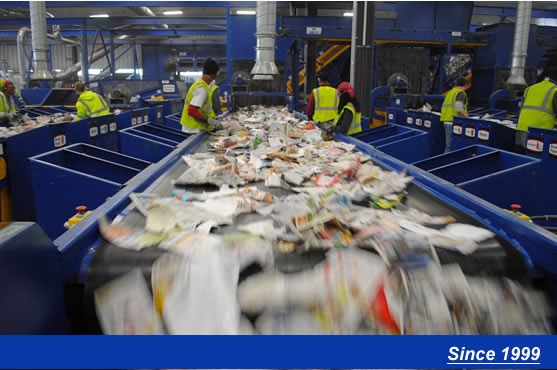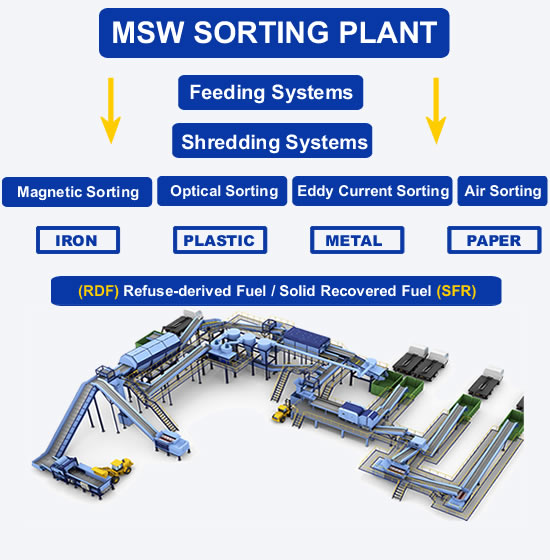100T/D MSW Sorting Plant
100T/D MSW Sorting Plant Solutions
MSWsorting Provide Complete Waste Sorting Machine and Equipment
Waste sorting machine generally refers to equipment which is separating different garbage according to certain regulations or standards. The purpose of classification is to increase the resource value and economic value of garbage, and strive to make the best use of materials. MSWsorting can get recycling materials separated from municipal solid waste, include glass, ferrous metal, aluminum, plastics, paper. Material is sorted to specifications, then shredded, compacted, baled for sale in market. MSWsorting also provide waste to energy solutions (RDF/SFR)


Using this garbage sorting machine guide, you can know the waste sorting machine work princicle
Of course, the waste sorting plant also uses other equipment to separate garbage. The principle and purpose of garbage sorting are to recycle, reduce and harmless
100T/D MSW Sorting Plant Solutions
300T/D MSW Sorting Plant Solutions
500T/D MSW Sorting Plant Solutions
Through waste sorting, useful materials such as paper, plastic, rubber, glass, bottles, cans, metals, and waste household appliances are separated from the garbage for recycling and reuse, turning waste into treasure. Not only improve the utilization level of garbage resources, but also reduce the amount of garbage disposal. It is an important way and means to achieve garbage reduction and resource utilization.The organic waste is composted and fermented, the organic waste is made into fertilizer for farmland and greening, the inorganic waste with no recycling value is landfilled, and the combustible waste with higher heating value is incinerated.

Export to 20+ countries

500+ Employees

Patent for Invention

Production Capacity(sets)
Stepping feeding systems have good input performance
Waste Conveying Systems OEM design is available
Double Shaft Waste Shredding Systems, 10-300mm sizes
Sorting and rycycling iron metal from mixted materials
Disc screening systems can deep crushing organic matter etc.
Ballistic separating systems can sorting 2D and 3D materials
Air Sorting Systems can separating lightweight and heavy materials
Optical Sorter can recycling single material: PET, Paper etc
Sorting food waste out from mixed garbage
Chapter 1: How to sort waste
1.Recyclable:It mainly includes five categories: waste paper, plastic, glass, metal and cloth.2. Kitchen waste:Food waste including leftovers, leftovers, bones, roots, leaves, peels, and other food waste are processed on-site by biotechnology to produce 0.3 tons of organic fertilizer.3. Harmful garbage:Including waste batteries, waste fluorescent tubes, wastewater silver thermometers, expired medicines, etc., these wastes need special safety treatment.4.Other garbage:Including hard-to-recycle waste such as bricks and tiles, ceramics, muck, toilet paper, and paper towels in addition to the above types of garbage, sanitary landfill can effectively reduce the pollution of groundwater, surface water, soil and air.
Chapter 2: The principles of garbage sorting
1. Principles of division and use. The purpose of classification is to classify waste as waste, use existing production capacity, recycle recycled products including materials and energy use, and dispose of temporarily unavailable waste. Classification is to increase the utilization of materials and reduce the amount of incineration and landfill. 2. Principles adapted to local conditions. Enterprises 'ability to recycle waste, residents' resources, living habits, economic and psychological capabilities are all the same. Convenience, applicable software and hardware facilities facilitate people and guide the public to correctly classify them. 3. Conscious autonomy. Communities and residents have gradually formulated a code of conduct for "reduction, recycling, consciousness and autonomy", innovated waste classification and treatment models, and became the main force for waste reduction, classification and recycling.
Chapter 3: Method of waste sorting
You don't have to worry too much when sorting garbage. The purpose of garbage classification is to facilitate the end-of-line processing and improve the efficiency of garbage processing. In the future, garbage classification may become more and more fine. Contributed. Priority should be given to ensuring the purity and accuracy of the three types of food waste, recyclables and hazardous waste, but other types of waste are inherently fault-tolerant. The treatment of other garbage is generally incineration, so as long as it is not too outrageous, even if there are some slight deviations, it will not affect the post-processing much. So if you do n't know exactly what kind of garbage, you may wish to put it in other garbage categories, which can help everyone reduce unnecessary tangles when sorting and placing, and also reduce the difficulty of sorting some garbage.
Chapter 4: Purpose and significance of waste sorting
The benefits of garbage sorting are obvious. The waste is sorted and sent to the factory instead of the landfill, which not only saves the land, but also avoids the pollution caused by landfill or incineration, and can also turn waste into treasure. In this battle of people and trash, people turned trash from friends into friends. Therefore, waste separation and collection can reduce the amount of waste treatment and treatment equipment, reduce the treatment cost, reduce the consumption of land resources, and have social, economic, and ecological benefits.
Chapter 5: How to sort waste metal from trash
1. The phenomenon of replacement of old and new in the use of metal products is inevitable. Due to the corrosion, damage and natural elimination of metal products, a large amount of waste metal is generated every year. If these waste metals are discarded at will, it will cause environmental pollution and waste limited metal resources. 2. The recycling and utilization of waste nonferrous metals is very necessary. The eddy current non-ferrous metal sorting machine sorts non-ferrous metal particles of different shapes. By adjusting the rotor speed, feeding speed, and belt speed, it achieves a good separation effect. It has very good applications in the fields of industrial decomposition and industrial slag recovery. 3. The ferrous metal can be well separated from the garbage by using a magnetic separator.
Chapter 6: How to sort waste plastic from trash
Waste plastics classification mainly includes landfilling, incineration and pyrolysis, and melting and recycling. In order to facilitate recycling, waste plastics should be classified first to facilitate the use of different processes for continued processing. Sorting methods include manual sorting, magnetic sorting, electrostatic stacking, pneumatic sorting and photoelectric sorting. The manual sorting method can be classified according to the type of resin based on experience, divided into different types of products such as tubes, films, foams, etc. or remove foreign substances in plastics such as metals, wood, paper, etc .; Removal of iron and steel impurities from plastics; electrostatic sorting is the use of plastics with different charging characteristics under electrostatic induction; pneumatic sorting is the use of different plastics with different resistances in the air. It can also be separated by photoelectric sorting according to the material of plastic.
Chapter 7: How to sort waste paper from trash
1. The classification of waste paper has a direct impact on the collection and disposal of waste paper. Different types of waste paper have different fiber types, components, and properties. Sorting waste paper can achieve the purpose of grading and making the best use of it.2. Using a bounce screen with sieve holes, use horizontal and vertical movement to separate waste paper into three categories: one is 3D shaped bottles, jars and other debris; the other is shredded paper and deink Small size (such as ≤50mm) scraps of paper, and a type of mixture of 2D sheet printing paper, wrapping paper, film, etc. 3. Then use the photoelectric sorter to further sort waste paper
Chapter 8: Status of Global Waste Sorting
Waste sorting has been carried out in developed countries around the world for a long time, such as Japan, Germany, and Sweden, and is currently in a relatively mature stage. Reviewing foreign experience in waste classification, we can summarize several aspects of experience: First, resource utilization is an important trend. From the development experience of countries with successful waste classification, we can see that these countries have largely turned waste into treasure by means of incineration to generate electricity or heat, compost, and recycling. Resource recovery utilization. Second, a good incentive and constraint mechanism. Economic incentives and legal constraints have an important impact on promoting residents' waste sorting. Third, a clear and clear garbage classification system. The classification is clear and operable, which helps residents to effectively classify domestic waste and reduce the cost of terminal treatment.
Chapter 9: Development of future waste sorting
1. AI intelligent identification alarm for household waste. Intelligent garbage compartment, which can collect and identify the domestic garbage images. 2. Intelligent domestic waste sorting and transportation. Different types of domestic garbage trucks automatically identify and sort garbage bins, and collect and transport them to ensure that they are sorted. 3. Automatic classification of domestic waste. Build an artificial intelligence-based intelligent garbage classification system through garbage data training and testing. 4.GPS garbage collection robot. Solve the problem that residents can't place garbage regularly. Residents can issue instructions through the APP. After receiving the order, the community robot can use its own GPS and motion sensors to locate the designated location of the resident. When it arrives at the designated place to meet the residents, the residents can put the garbage into a specific pocket of the robot, and the robot will automatically put the garbage into different trash bins.
Sorting and Recycling Solution include from waste feeding systems to baling systems
This solutions include composting equipment for food & organic waste except sorting equipment
Provide RDF/SFR making and drying equipment after sorting and recycling sytems